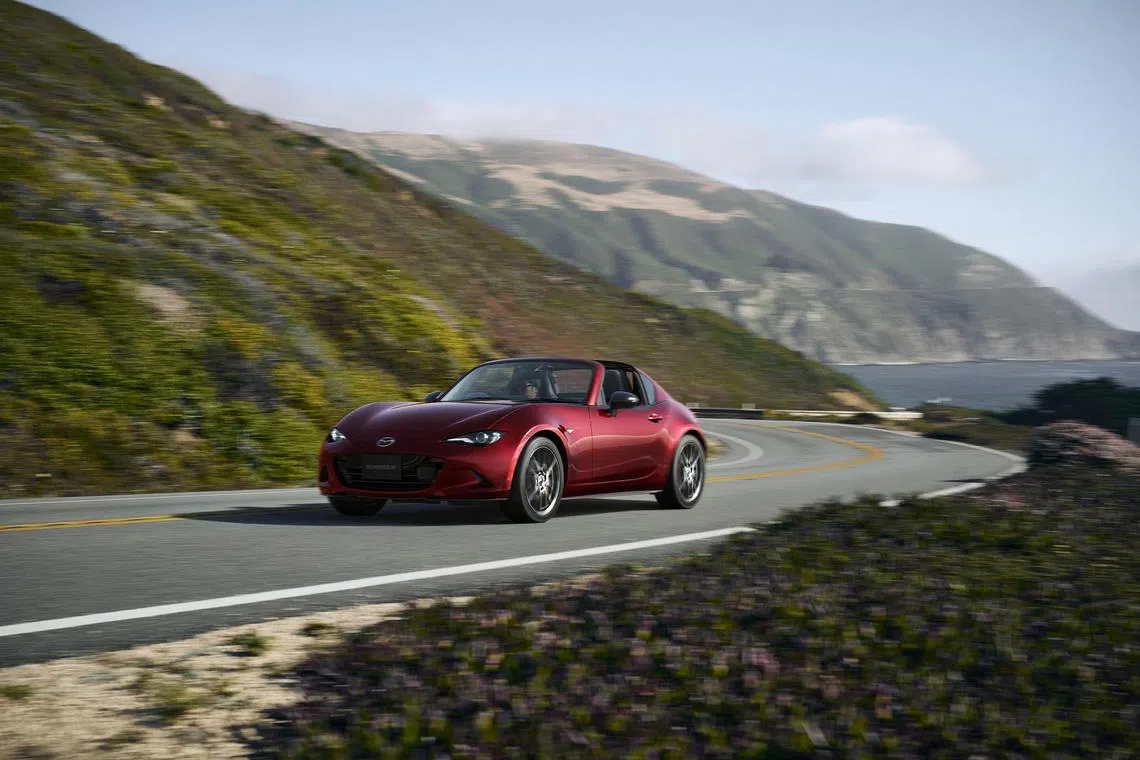Fast Lane: BMW’s fourth electric crossover, EV insurance with protection against hackers
Sign up now: Get ST's newsletters delivered to your inbox

BMW iX2: Sizeable sizzler.
PHOTO: BMW
Follow topic:
BMW iX2 and iX1 arriving early next year
BMW has unveiled a new X2, along with its first compact electric crossover, the iX2, which is slated to arrive late in the first quarter of 2024.
The new X2 has grown by 194mm in length over its predecessor to 4,554mm, by 21mm in width to 1,845mm and by 64mm in height to 1,590mm. It has a luggage capacity of 560 litres, with the iX2 offering a little less at 525 litres.
The first electric variant will be the iX2 xDrive30, which is powered by two motors with a combined output of 230kW and 494Nm. The all-wheel drive hits 100kmh in 5.6 seconds and a top speed of 180kmh. With a 64.8kWh battery, it promises a range of up to 449km.
The long-delayed iX1, meanwhile, is slated to debut at the Singapore Motorshow in January 2024.
Insurance which covers damage caused by hackers
Motor insurer Allianz has introduced a policy specifically for electric vehicles (EVs) that covers loss or damage arising from malicious cyber acts – even when the vehicle is operated under Advanced Driver Assistance Systems (semi-autonomous mode). And if the car is less than two years old and damaged beyond repair, it will be replaced with a new one.
The policy also extends a lifetime warranty on repairs that covers rectification of workmanship defects.
Renault Clio to have dual-motor hybrid variant

Renault Clio: A 1.6-litre dual-motor hybrid joins 1-litre three-cylinder sibling.
PHOTO: RENAULT
Renault is adding a new drivetrain option to its new Clio subcompact.
Besides a 1-litre three-cylinder petrol engine, the Clio will have a full hybrid variant. The latter pairs a 1.6-litre four-cylinder engine with two electric motors powered by a 1.2kWh lithium-ion battery.
Renault claims the car can use the motors up to 80 per cent of the time in city driving, cutting consumption by up to 40 per cent, compared with an equivalent 1.6-litre non-hybrid.
Volvo EX30 to be made in China, Belgium
Volvo Cars is adding a new production line for its EX30 compact electric crossover at its Ghent plant in Belgium from 2025. Production of the car started earlier this year in Zhangjiakou, China, and the first cars are scheduled to reach customers later this year.
The Ghent move underlines Volvo’s forecast that the EX30 will be one of its best-selling models in the coming years.
Mazda updates MX-5, unveils hybrid roadster concept

Mazda MX-5: Refreshing a classic.
PHOTO: MAZDA
Mazda has unveiled a 2024 update of its MX-5 as well as a hybrid concept called Iconic SP. The current MX-5 was launched in 2015.
The update includes reshaped lights all round. The headlights with daytime-running lights are full LED and the same goes for the rear lights.
Inside, there is a larger 8.8-inch infotainment touchscreen and a refreshed instrument panel. A frameless rear-view mirror completes the internal revamp.
The Iconic SP concept pairs a dual-rotary engine with an electric motor. The engine acts as a generator, which will keep the car’s traction battery charged. Mazda says the engine will use a variety of fuels, including hydrogen.
Porsche to use low-carbon steel from 2026
Porsche has teamed up with Swedish energy start-up H2 Green Steel to use carbon-reduced steel for its cars.
H2 Green Steel plans to produce steel using renewable energy in Boden, Sweden, starting from the end of 2025.
From 2026, Porsche and various direct Porsche suppliers will be supplied with low-emission steel from the start-up. It claims that the steel has the lowest carbon footprint on the market, or up to 95 per cent smaller than conventional steel production.
Up to 35,000 tonnes of the low-emission steel will be used a year for the series production of Porsche vehicles. In 2022, Porsche used 220,000 tonnes of steel to produce its cars.
Electric Volkswagen wagon to have up to 1,714 litres of stowage

Volkswagen ID7 Tourer in disguise: Looks taller than many wagons.
PHOTO: VOLKSWAGEN
The electric Volkswagen ID7 will have a station wagon variant called the ID7 Tourer, which will be launched in Europe next year.
Volkswagen’s first electric wagon – shown here camouflaged – will have a boot volume of 545 litres. With rear seats collapsed, the capacity goes up to 1,714 litres.
Polestar 4 less carbon-intensive than smaller Polestar 2
Swedish electric carmaker Polestar has published a life-cycle assessment of its Polestar 4, which shows that the new crossover has the lowest carbon footprint of all Polestar cars to date.
The car will be produced at parent group Geely Holdings’ factory in Hangzhou Bay, China, which combines hydropower with photovoltaic electricity from the roof of the plant. A higher use of low-carbon aluminium from smelters using hydropower helps reduce carbon further.
Aluminium represents 23 to 24 per cent of the carbon footprint, while steel and iron constitute 20 per cent and battery modules account for the highest share of 36 to 40 per cent.
The production of the Polestar 4 is said to involve as little as 19.4 tonnes CO2 equivalent, or some 17 per cent less than that of the Polestar 2, which is a smaller vehicle.
New E-class Estate offers more space for occupants, cargo

Mercedes-Benz E-class Estate: Quick for a big car with a smallish engine.
PHOTO: MERCEDES-BENZ
The latest Mercedes-Benz E-Class Estate offers a luggage capacity of up to 1,830 litres when its rear seats are folded.
The car is wider and has a longer wheelbase than its predecessor, offering rear passengers more room.
It is initially available with four-cylinder petrol, four-cylinder diesel or plug-in hybrid powertrains, including a 2-litre nine-speed automatic with a claimed century sprint time of 7.8 seconds and a top speed of 230kmh.


